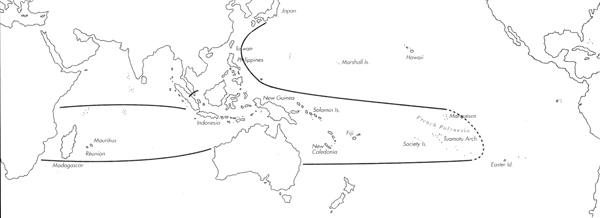
Skip Navigation Links
View access keys for this site.

Range: Indian Ocean: Madagascar and Réunion to W. Australia; Pacific: Japan to New Caledonia, Fiji, and French Polynesia.
Description: Small to moderately large, moderately solid to solid; shells of form sugillatus larger than those of typical form. Last whorl conical; outline variably convex above centre, straight below. Shoulder angulate, smooth to strongly tuberculate. Spire of low to moderate height, outline slightly concave to slightly convex. Larval shell of about 3 whorls, maximum diameter 0.7-0.8 mm. Early postnuclear spire whorls smooth, later whorls smooth, undulate or tuberculate; tuberculation weaker in form sugillatus. Teleoconch sutural ramps flat to weakly concave, with 1 increasing to 3-4 spiral grooves. Sculpture of last whorl varies from smooth spiral ribs at base to strongly granulose spiral ribs on entire whorl; in form sugillatus sculpture weaker and restricted to base.
| Shell Morphometry | ||
|---|---|---|
| L | 23-31 mm | |
| RW | 0.10-0.20 g/mm | |
| RD | 0.59-0.65 | |
| PMD | 0.86-0.95 | |
| RSH | 0.10-0.20 | |
Ground colour white to greyish white, often suffused with bluish shades. In typical form (Pl. 9, Figs. 8-10), last whorl with a variably broad, yellowish brown spiral band on each side of centre; bands sometimes additionally tinged with olive. Distinctly and obsolety banded shells intergrade. Dashed and dotted or solid brown spiral lines extend from base to subshoulder area, varying in number and arrangement. Base, siphonal fasciole and basal part of columella dark bluish to brownish violet. Larval whorls orange. Teleoconch sutural ramps with sparse to numerous brown radial markings, sometimes immaculate. Aperture violet at base; remaining area immaculate or external pattern visible within.
Periostracum yellowish brown, thin, and slightly translucent, with widely spaced spiral rows of tufts on last whorl.
In form sugillatus (Pl. 9, Figs. 6, 7, 11), colour bands of last whorl usually darker, often tinged with dark bluish green or greenish brown. Central and subshoulder band may be overlaid with yellowish brown. Brown spiral lines usually solid. Teleoconch sutural ramps often greenish brown toward apex. Aperture dark violet, with a pale band at centre and subshoulder area. Periostracum usually less translucent than in typical form. In typical form (Pl. 74 Fig. 15), dorsum of foot pink and dotted with white and black, red at its extremities; marginal zone with radiating dotted black lines. Sole of foot, rostrum, tentacles and siphon red, dotted with white and black; an additional pale grey band near centre of siphon (Chaberman, pers. comm., 1981). In form sugillatus (Pl. 74, Fig. 16), entire animal brick to greyish red, heavily dotted with white and black; dorsum of foot darker red at anterior end, with red spot beneath operculum and occasionally lacking white dots; sole of foot less densely dotted, occasionally without dots (Chaberman, pers. comm.; 1981; Estival, 1981).
Habitat and Habits: Intertidal to about 70 m; living on coarse sand with algae, and on diverse reef substrates. In some areas, found only subtidally (New Caledonia: in 12-40 m; Marshall Is.: slightly subtidal zone to 70 m). C. muriculatus feeds on eunicid and nereid polychaetes (Marshall Is., Kohn, 1980a; as C. sugillatus). On Broadhurst Reef (off Townsville, Queensland), form sugillatus has been observed spawning under coral rubble in 10 m (Loch, pers. comm., 1987). In an aquarium, typical form has deposited egg capsules in groups of 4 (Chaberman, pers. comm., 1981).
Discussion: The typical form of C. muriculatus closely resembles C. floridulus in shell characters and colour pattern of the animal. The latter can be distinguished by its larger size, lighter spiral colour bands, and light violet size, in contrast to the dark bluish or brownish violet base of C. muriculatus. Additonal differences are seen in the colouration of the animals.

C. muriculatus Range Map
This section contains verbatim reproductions of the accounts of 316 species of Conus from the Indo-Pacific region, from Manual of the Living Conidae, by Röckel, Korn and Kohn (1995). They are reproduced with the kind permission of the present publisher, Conchbooks.
All plates and figures referred to in the text are also in Röckel, Korn & Kohn, 1995. Manual of the Living Conidae Vol. 1: Indo-Pacific Region.
The range maps have been modified so that each species account has it own map, rather than one map that showed the ranges of several species in the original work. This was necessary because each species account is on a separate page on the website and not confined to the order of accounts in the book.
Return to framed version (returns to search page)